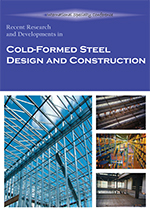Session Dates
24 Aug 2012 - 25 Aug 2012
Abstract
The objective of this paper is to explore computational modeling of a coldformed steel framed building subjected to earthquake excitation. The selected two-story building will be subjected to full-scale motion on a shaking table in 2013 as part of the National Science Foundation funded Cold-Formed Steel – Network for Earthquake Engineering Simulation (CFS-NEES) project. The ledger-framed building employs load bearing cold-formed steel members throughout (wall, floors, and roofs) and employs OSB sheathed shear walls and an OSB sheathed diaphragm for the lateral force resisting system. Two- and three-dimensional analysis models capable of providing vibration, pushover, linear and nonlinear time history analysis are created in OpenSees. To date, the key nonlinearity investigated in the models is the characterization of the shear walls. The shear walls are either modeled as (a) elastic perfectly plastic, consistent with “state of the practice” level knowledge from AISI-S213 or (b) fully hysteretic with pinching and strength degradation based on shear walls tests conducted specifically for this building. The impact of the diaphragm stiffness is also investigated. Interaction of the lateral and gravity system, interaction of the joists, ledger, and walls, and the impact of openings on the diaphragm all remain for future work. The model is being employed to help determine the predicted experimental performance and develop key sensor targets in the response. In addition, the model will be used in incremental dynamic analysis to explore seismic performance-based design and sensitivity to model fidelity (2D, 3D, etc.) for cold-formed steel framed buildings.
Department(s)
Civil, Architectural and Environmental Engineering
Research Center/Lab(s)
Wei-Wen Yu Center for Cold-Formed Steel Structures
Meeting Name
21st International Specialty Conference on Cold-Formed Steel Structures
Publisher
Missouri University of Science and Technology
Document Version
Final Version
Rights
© 2012 Missouri University of Science and Technology, All rights reserved.
Document Type
Article - Conference proceedings
File Type
text
Language
English
Recommended Citation
Leng, J.; Schafer, B. W.; and Buonopane, S. G., "Seismic Computational Analysis of CFS-NEES Building" (2012). CCFSS Proceedings of International Specialty Conference on Cold-Formed Steel Structures (1971 - 2018). 4.
https://scholarsmine.mst.edu/isccss/21iccfss/21iccfss-session11/4
Seismic Computational Analysis of CFS-NEES Building
The objective of this paper is to explore computational modeling of a coldformed steel framed building subjected to earthquake excitation. The selected two-story building will be subjected to full-scale motion on a shaking table in 2013 as part of the National Science Foundation funded Cold-Formed Steel – Network for Earthquake Engineering Simulation (CFS-NEES) project. The ledger-framed building employs load bearing cold-formed steel members throughout (wall, floors, and roofs) and employs OSB sheathed shear walls and an OSB sheathed diaphragm for the lateral force resisting system. Two- and three-dimensional analysis models capable of providing vibration, pushover, linear and nonlinear time history analysis are created in OpenSees. To date, the key nonlinearity investigated in the models is the characterization of the shear walls. The shear walls are either modeled as (a) elastic perfectly plastic, consistent with “state of the practice” level knowledge from AISI-S213 or (b) fully hysteretic with pinching and strength degradation based on shear walls tests conducted specifically for this building. The impact of the diaphragm stiffness is also investigated. Interaction of the lateral and gravity system, interaction of the joists, ledger, and walls, and the impact of openings on the diaphragm all remain for future work. The model is being employed to help determine the predicted experimental performance and develop key sensor targets in the response. In addition, the model will be used in incremental dynamic analysis to explore seismic performance-based design and sensitivity to model fidelity (2D, 3D, etc.) for cold-formed steel framed buildings.



